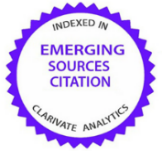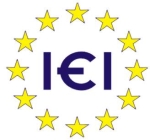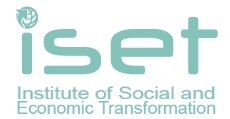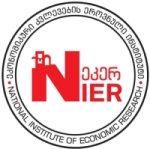Branch Structure of the National Economy and Directions of its Optimization in the Post-War Period
Abstract
Introduction. The war in Ukraine caused significant damage to the economy, but also provided many new opportunities, made adjustments to the paradigm of post-war economic development, in particular, in view of the need to rebuild industries and ensure the reliability of their operation in the future, the variability of logistics supply routes. The complexity of post-war reconstruction is aggravated by the fact that Ukraine must modernize the defense industry and, at the same time, reduce the country's budget deficit, which requires an increase in budget revenues. The radical changes necessary for this will require optimization of the sectoral structure of the country's economy.
Aim and tasks. The purpose of the study is to create a methodological approach to the sectoral optimization of the national economy in the post-war period and, for this, to develop a structural-mathematical model, determine priority areas of development of branches, and mechanisms of structural optimization of branch development.
Results. A methodological approach to sectoral optimization of the national economy in the post-war period was developed, in which a structural-mathematical model was implemented. To optimize the industry structure, the use of a "trigger" mechanism is proposed: when the stimulation of the development of individual projects in high-tech industries leads to the rapid development of adjacent sectors of the economy, The need for comprehensive use of intensive and extensive mechanisms of post-war economic restructuring is indicated due to the specifics of the development of industries, the significant industry differentiation of damages and losses, and the need for expenses for the transformation and restructuring of industries. A diversification approach with the selection of short-, medium-, and long-term industry strategies was proposed.
Conclusions. The developed mathematical model allows for the combination of sectoral optimization strategies of the economy and optimization coordination of sectoral strategies at the national level. An assessment of the costs of reconstruction and industry transformation was carried out, and the application of internal financing mechanisms, in particular, an increase in the level of added value, was substantiated. The mathematical model illustrates the possibility of maximizing the added value. Considering this, directions for industry optimization and prerequisites for restoration, reconstruction, and optimization of the industry structure in the post-war period are proposed. The given areas of industry-wide impact of the trigger mechanism indicate the prospects of its introduction.
Keywords:
branch structure, post-war period, strategy differentiation, trigger principle, structural-mathematical model.References
Arefieva, O., & Antonenko, K. (2023). Analysis of the consequences of the war for the economy of Ukraine. Economics and Business Management, 71, 98-102. https://doi.org/10.32782/infrastruct71-18
Bioko, V., & Bioko, L. (2023). Industrial parks as an efficient mechanism of attracting investments for economic recovery in a post-war period. Economy and Society, 49. https://doi.org/10.32782/2524-0072/2023-49-23
Borodina, O., & Lyashenko, V. (2022). Post-War Economic Recovery: World Experience and Attempt to Adapt it for Ukraine. Herald of the Economic Sciences of Ukraine, 1 (42), 121-134. https://doi.org/10.37405/1729-7206.2022.1(42).121-134
Bortnik, R. (2022). On the Current Globalization and the Causes of the Russian-Ukrainian War. Ukrainian Policymaker, 11, 19-25. https://doi.org/10.29202/up/11/3
Chkheailo, A., & Kukhar, D. (2022). Financial Stability and Resistance of Bank in the Current Conditions of Martial Law. Financial and Credit Systems: Prospects for Development, 3(6), 7-15. https://doi.org/10.26565/2786-4995-2022-3-01
Deineko, L. V., Kushnirenko, O. M., Tsyplitska, O. O., & Gakhovich, N. G. (2022). Inheritance of full-scale military aggression Russian Federation for Ukrainian industry. Economy of Ukraine, 5, 3-25. https://doi.org/10.15407/economyukr.2022.05.003
Gochua, A., & Gibradze, G. (2022). The Impact of Russia’s Soft Power on Georgia and Economic Relations. Future Human Image, 17, 14-19. https://doi.org/10.29202/fhi/17/3
Gorodnichenko, Y., Sologoub, I. & di Mauro, B.W. (Eds.). (2022). Rebuilding Ukraine: Principles and policies. Paris Report 1, Centre of Economic Policy Research.
International Monetary Fund. (2023). Macroeconomic & Financial Data. https://data.imf.org
Irtyshcheva, I., Kramarenko, I., & Sirenko, I. (2022). The economy of war and postwar economic development: world and Ukrainian realities. Baltic Journal of Economic Studies, 8(2), 78-82. https://doi.org/10.30525/2256-0742/2022-8-2-78-82
Ivanov, S. (2019). Economic recovery and development ocountries after armed conflicts and wars: Ukraine’s opportunities that have not lost yet. Economy of Ukraine, 1, 75-89. https://doi.org/10.15407/economyukr.2019.01.075
Izha, M., & Pakhomova, T. (2022). Conceptual Approaches to Innovative Mechanisms Public Administration of Territories Recovery. Aspects of public administration, 10(3), 5-10. https://doi.org/10.15421/152214
Kaflyk, M. (2022). Financial system of Ukraine during the martial law. Economics. Finances. Law, (5/2), 10–13. https://doi.org/10.37634/efp.2022.5(2).2
Kaletnik, G., & Lutkovska, S. (2021). Implementation of Public-Private Partnership Models in the Field of Ecological Modernization of the Environmental Safety System. European Journal of Sustainable Development, 10(1), 81. https://doi.org/10.14207/ejsd.2021.v10n1p81
Khatser, M. (2022). Socio-economic challenges of Ukraine in the war and post-war period. Management and Entrepreneurship: Trends of Development, 4(22), 86-95.
Khmarska, I., Kucheriava, K., & Klimova, I. (2022). Features of the post-war recovery of the economy of Ukraine. Economy and society, 42. https://doi.org/10.32782/2524-0072/2022-42-31
Kinash, I., Andrusiv, U., Golovnia, O., & Popadynets, I. (2019). Aspects of the formation and development of innovation infrastructure in Ukraine. Management Science Letters, 9 (13), 2403-2414. https://doi.org/10.5267/j.msl.2019.7.015
Kindzerskyi, Yu. (2022). Post-war recovery of Ukraine's industry: challenges and features of policy. Economic Analysis, 32(2), 101–117. https://doi.org/10.35774/econa2022.02.101
Koblianska, I., Seheda, S., Khaietska, O., Kalachevska, L., Klochko, T. (2022). Determinants of potato producer prices in the peasant-driven market: the Ukrainian case. Agricultural and Resource Economics, 8(3), 26–42. https://doi.org/10.51599/are.2022.08.03.02
Kosovych, B. (2022). Innovative development of Ukraine in the conditions of war and post-war period. Economics & Education, 7(4), 6-12. https://doi.org/10.30525/2500-946X/2022-4-1
Kubalskyi, O. (2022). Social Turbulence as the Scientific Phenomenon: Operational and Strategic Change. Philosophy and Cosmology, 29, 17-25. https://doi.org/10.29202/phil-cosm/29/2
Kucherenko, S. (2023). The 'Marshall Plan' is cancelled: How the IMF sees Ukraine's post-war recovery. https://mind.ua
Kyrylenko, V. I., Tkachenko, O. V., Kotenok, A. G., Sarkisian, H. O., & Sitkovska, A. O. (2022). The Role of Innovative Technologies in Ensuring the Competitiveness of the Enterprise. Naukovyi Visnyk Natsionalnoho Hirnychoho Universytetu, 5, 185-190. https://doi.org/10.33271/nvngu/2022-5/185
Michňová, M., & Megyesiova, S. (2022). The Impact of The Economic and Covid-19 Crises on the Visegrad Group Countries. Naukovyi Visnyk Natsionalnoho Hirnychoho Universytetu, 6, 142-146. https://doi.org/10.33271/nvngu/2022-6/142
Okhrimenko, O., Chynchyk, A., Dergach, A., Bannikova, K., & Nesterenko, O. (2022). Strategies for economic development: the Ukrainian case. Revista Amazonia Investiga, 11(55), 234–248. https://doi.org/10.34069/ai/2022.55.07.25
Ostrovska, H., Tsikh, H., Strutynska, I., Kinash, I., Pietukhova, O., Golovnya, О., & Shehynska, N. (2021). Building an effective model of intelligent entrepreneurship development in digital economy. Eastern-European Journal of Enterprise Technologies, 6(13), 49–59. https://doi.org/10.15587/1729-4061.2021.244916
Pavlov, V., Shtuler, I., Gerasymchuk, N., Mirzoieva, T., Lisovyi, A., Kucher, I. (2022). Concept of National Innovation System: Etymologization and Complications of Management. Naukovyi Visnyk Natsionalnoho Hirnychoho Universytetu, 5, 191-196. https://doi.org/10.33271/nvngu/2022-5/191
Qu, Y., & Mardani, A. (2023). Market orientation, technological opportunity, and new product innovation performance. Journal of Business Research, 162(2), 113841. https://doi.org/10.1016/j.jbusres.2023.113841
Redziuk, Y. (2022). Transformation of Global Capital Markets Under the Influence of Military Aggression Against Ukraine. Financial and Credit Systems: Prospects for Development, 2(5), 48-55. https://doi.org/10.26565/2786-4995-2022-2-05
Soroka, L., & Ovcharenko, O. (2022). Ensuring the National Security of Ukraine Through the Standardization of Space Activities. Advanced Space Law, 9, 81-92. https://doi.org/10.29202/asl/9/8
StartupBlink. (2023). The Global Startup Ecosystem Index Report 2023. https://lp.startupblink.com
State Statistics Service of Ukraine. (2023). Economic statistics. International economic activity and balance of payments. (2023). https://ukrstat.gov.ua
Sydoruk, B., Sava, A., Korzhenivska, N., Zdyrko, N., Khaietska, O. (2021). Optimization of economic and ecological components of using agricultural lands for balansed land use and rural areas development. Independent Journal of Management & Production, 12 (6), 417-430. https://doi.org/10.14807/ijmp.v12i6.1767
Yakushik, V. (2021). In Search of Conceptual Platforms for East-West Cooperation, Global and Regional Integration Projects. Philosophy and Cosmology, 27, 174-183. https://doi.org/10.29202/phil-cosm/27/14
Zayed, N.M., Edeh, F.O., Islam, K.M.A., Nitsenko, V., Polova, O., & Khaietska, O. (2022). Utilization of Knowledge Management as Business Resilience Strategy for Microentrepreneurs in Post-COVID-19 Economy. Sustainability, 14(23), 15789. https://doi.org/10.3390/su142315789
Zveryakov, M. I. (2022). Formation of the model of economic development in new historical realities. Economy of Ukraine, 8, 03–19. https://doi.org/10.15407/economyukr.2022.08.003
If the article is accepted for publication in the journal «Economics. Ecology. Socium» the author must sign an agreementon transfer of copyright. The agreement is sent to the postal (original) or e-mail address (scanned copy) of the journal editions.





















